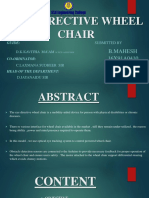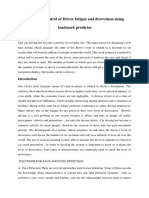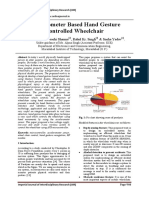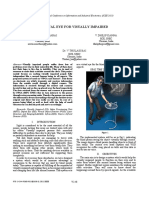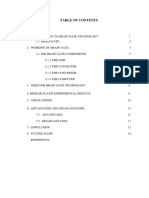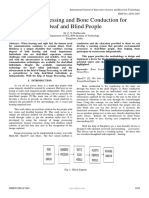Professional Documents
Culture Documents
Eyeball Operated Wheelchair For Locked in Syndrome Patient
Original Title
Copyright
Available Formats
Share this document
Did you find this document useful?
Is this content inappropriate?
Report this DocumentCopyright:
Available Formats
Eyeball Operated Wheelchair For Locked in Syndrome Patient
Copyright:
Available Formats
Volume 3, Issue 5, May – 2018 International Journal of Innovative Science and Research Technology
ISSN No:-2456-2165
Eyeball Operated Wheelchair for Locked-In
Syndrome Patient
Gagandeep Singh
Department of Electronics and Communication Engineering, New Delhi, India
Abstract:- The aim of the paper is to develop an efficient what all is happening in its surrounding environment but
eyeball movement tracking interface and to control the cannot move or communicate verbally due to complete
movement of wheelchair using tracking information. paralysis of almost all voluntary muscles in the body except
Locked-in syndrome is a condition in which a patient is for eye movements and blinking.
aware of the surroundings but cannot move or
communicate verbally due to complete paralysis of almost Locked-in syndrome is most often caused by damage to
all voluntary muscles in the body except for eye a specific part of the brainstem known as the pons. The pons
movements and blinking. The individual is conscious with contains important neuronal pathways between the cerebrum,
no loss of cognitive function and thus is able to spinal cord and cerebellum. In locked-in syndrome there is an
communicate with eye movements. This condition is also interruption of all the motor fibers running from grey matter in
known as pseudo coma. This paper gives information the brain via the spinal cord to the body’s muscles and also
about how eyeball movement of LIS patients can be damage to the centers in the brainstem important for facial
detected and how we can use this information to move a control and speaking.
wheelchair in direction of the eyeball. We continuously
capture the images of either the left or the right eye using a Locked-in syndrome (LIS) patients generally
head mounted web camera. Highly accurate and fast communicate with others through coded messages by moving
movement in the eye region of image is detected as the eye or blinking their eyes, which are not affected by the paralysis.
is stationary with respect to the webcam. To control The symptoms of locked-in syndrome and that of sleep
starting and stopping of wheelchair eye blinking feature is paralysis are quite similar. Consciousness is preserved in
used by the algorithm as LIS patients can only move and locked-in syndrome. Sometimes they can retain the ability to
blink their eyes. In this paper, accurate and high speed eye sense stimuli and sensation throughout their bodies. Some
detection and tracking algorithm using video processing in patients may have the ability to move some or all of the
MATLAB is proposed. extraocular muscles and some facial muscles. Though the
vocal cords of patient with locked-in syndrome are not
Keywords:- Eyeball movement; wheelchair; PIC16F877A; paralyzed they lack coordination between breathing and voice
MATLAB; locked-in syndrome. which prevents them from producing voluntary sound.
I. INTRODUCTION Since no cure or standard treatment for LIS is available,
Eye tracking is a technique in which eye movements of therefore, eye tracking technique can be used to help people
an individual are measured to know where the eyes are with LIS communicate with their environment using
focused. This technique is used to know the time interval for interactive interface.
which a person eye is focused to any location at any given
time and the sequence in which person eye is changing its Since these people find it difficult to drive a wheelchair
focus from one location to another. using their arms or legs or voice command, so driving it using
their eyes become an effective method.
As an advantage to certain population of disable
individual, control signals generated by capturing eye ball II. PROPOSED MODEL
movement can be used by this individual to interact with
interfaces directly without use of any external peripheral like
mouse or keyboard.
Mathematical morphology is a theory that provides a
wide range of operators for analysis and image processing, all
based on simple mathematical concepts from set theory,
topology and random functions. The operators are particularly
useful for the analysis and transformation of the binary or
grayscale images and for some common usages like edge
detection, noise removal, image segmentation and image
enhancement.
Fig 1:- General block diagram of wheelchair
Millions of people are suffering from Locked in
syndrome (LIS). Locked-in syndrome (LIS), also known as The system operates on basis of eye movement which is
pseudo coma, is a condition in which a patient is aware of fed as an input signal to control the motion of wheelchair in
IJISRT18MY456 www.ijisrt.com 738
Volume 3, Issue 5, May – 2018 International Journal of Innovative Science and Research Technology
ISSN No:-2456-2165
any direction. The camera is mounted on head cap such that it Webcam captures HD images of position of the eye. The
focuses on eye, analyses the eye ball movement of the person webcam sends the images to the MATLAB environment for
and microcontroller accelerates the vehicle. image processing. Serial data received from the MATLAB
every 1 millisecond after image processing is fed to the
Moreover, stopping of wheelchair is controlled by the embedded microcontroller PIC16F877A which is used to
blinking of eye. To stop a wheelchair individual need to close control the motors.
the eye for a predefine number of seconds, the wheelchair will
stop with a predefine delay to avoid jerk. Delay function has For different eye positions, different control signals are
been implemented for smooth starting and stopping of the generated by MATLAB code. This generated signal is send to
wheelchair. the serial port. Microcontroller read the data from serial port
and drives the motor using motor driver circuit according to
the serial data.
III. MATLAB INTERFACING
Fig 2:- Flowchart of image processing
IJISRT18MY456 www.ijisrt.com 739
Volume 3, Issue 5, May – 2018 International Journal of Innovative Science and Research Technology
ISSN No:-2456-2165
Initialize serial port communication at 9600 Baud rate; V. HARDWARE
using USB interface the digital camera with laptop/PC.
Program MATLAB to capture image from the camera
interfaced at 20frames/sec. Focus the camera on the eye by
mounting it on the head cap.
Once the colored image of eye is captured, it is then
transformed to a gray scale image. Gray scale image represents
an image as a matrix where every element has a value
corresponding to how bright or dark the pixel at the
corresponding position should be color.
Then adjust the intensity value of gray scale image by
saturating pixel values. This operation increases the contrast of Fig 4:- Block diagram of hardware of circuit
the output image. Extract feature of the eye and to get the
location of the eye ball.
A. Microcontroller
Divide image into three segments of pixel and find the PIC16F877A is a powerful easy-to-program
location of feature pixel and send the data to serial port, to be microcontroller with 200 nanosecond instruction execution
read by microcontroller to control the direction of movement. cycle. PIC16877A is CMOS FLASH-based 8-bit
microcontroller. The PIC16F877A features 8 channels of 10-
IV. MICROCONTROLLER INTERFACING bit Analog-to-Digital (A/D) converter, an ICD, 256 bytes of
EEPROM data memory, 2 comparators, Universal
With the help of DB9 cable, microcontroller connected Asynchronous Receiver Transmitter (USART), 2
to MAX232 will receive the data from MATLAB. capture/compare/PWM functions, and synchronous serial port
Microcontroller will compare the data and give required which can be configured as either 3-wire Serial Peripheral
command to motor driver circuit for the movement of motors. Interface (SPI) or the 2-wire Inter-Integrated Circuit (I²C) bus.
All of these features make it ideal for more advance
applications in industrial, automotive and consumer
applications.
B. Motor driver
L293D is a Motor Driver IC usually used to control DC
motor on either forward or reverse direction. This 16 pin IC is
designed to control two motor simultaneously using two H-
Bridge in any direction. It acts as an interface between
microcontroller and motors. It consists of Dual H-bridge
circuit. Low current rated motors are controlled using H-
bridge.
Rotation of motor connected across left side will be
regulated by left input pins and right motor will be regulated
by right input pins. Rotation of motor is based on input
provided in form of Logic 1 or Logic 0.
C. Motor
Our wheelchair circuit uses two DC geared motors to
drive the wheelchair in forward, backward, left and right
directions using input from motor driver IC. Motors are
powered using rechargeable and easily replaceable 12v 15Ah
battery.
D. MAX232
TX, RX, CTS, and RTS signals are converted using dual
transmitter/dual receiver IC named MAX232. The signals
Fig 3:- Flowchart for microcontroller from RS-232 are converted to TTL circuit signals. In
MAX232, RS-232 to TTL voltage level conversion is done
using two receivers and TTL to RS-232 voltage level
conversion is carried out by two drivers.
IJISRT18MY456 www.ijisrt.com 740
Volume 3, Issue 5, May – 2018 International Journal of Innovative Science and Research Technology
ISSN No:-2456-2165
TX and RX uses first driver-receiver pair of MAX232 and
CTS and RTS uses the second driver-receiver pair.
E. DB9 cable
DB9 is common connector of D-Sub types of connector.
It has 9 pins for male connector and 9 holes for female
connector.
DB9 type connectors are designed to work with the
EIA/TIA 232 serial interface standard. DB9 connectors were
commonly used for serial communication. Many peripheral
devices like keyboards, mice, joysticks, etc. are interfaced
using DB9 cable.
Fig 8:- Eyeball position for left movement
VII. ACKNOWLEDGMENT
A patient suffering from complete locked-in syndrome
has an ability to move or blink eyes only. The idea is to design
a human-machine interface that can provide a power to the
patient, of controlling the wheelchair movement with respect
to the movement of eyeball.
Since the wheelchair make the LIS patient feel more
independent and gives the control of the movement of
wheelchair to the patient according to their will or desire the
name given to this wheelchair is “Willchair”.
Fig 5:- Circuit diagram for microcontroller
REFERENCES
VI. SIMULATION RESULT
[1] Sanjay Talbar & Rajesh Bodade, “Novel Approach of
Accurate Iris Localization from High Resolution Eye
Images Suitable for Fake Iris Detection”, 2010.
[2] Roger Bostelman, James Albus, 2007, “A Multipurpose
Robotic Wheelchair And Rehabilitation Device For The
Home”, NistGaithersburg.
[3] SelvaganapathyMonoharan, NishavithriNatarajan, “Brain
Controlled Wheelchair for Physically Challenged People
using Neuro-Sky Sensor”,IJIRSET, December 2015.
Fig 6:- Eyeball position for forward movement [4] Rahul Agarwal, AkramSiddiqui, Kuvendra Singh,
ArjunSolanki, LavitGautam, 2016, “A Voice Controlled
Wheel Chair Prototype for a Medically Challenged”,
IJETT.
[5] P.D. Khandait, R.C. Thool & S.P. Khandait, “Extraction
of Facial Feature Components for Expression
Recognition”, International journal of information
technology and knowledge management,2010.
[6] Ahmet, V. & Hilmi, K, “Design of Voice Controlled
Vehicle”, International Conference on Advances
Automotive Technologies 2016.
[7] Sreedhar V S, Deepa K B, Prashanth Kumar H.K , Chaitra
M, Ankit Kumar Sharma , “Accident Prevention by Eye
Fig 7:- Eyeball position for right movement Blink Sensor and Alcohol Detector”, International Journal
of Engineering Research, 2015.
IJISRT18MY456 www.ijisrt.com 741
You might also like
- Advances in Embedded Computer VisionFrom EverandAdvances in Embedded Computer VisionBranislav KisačaninNo ratings yet
- Eye Ball Cursor MovementDocument4 pagesEye Ball Cursor MovementInternational Journal of Innovative Science and Research TechnologyNo ratings yet
- 3.3.5 - 146 - A Device Controlled Using Eye MovementDocument4 pages3.3.5 - 146 - A Device Controlled Using Eye MovementPooja ChendakeNo ratings yet
- Sensor Based Eye Controlled Automated Wheelchair: Shreyasi Samanta and Mrs. R DayanaDocument4 pagesSensor Based Eye Controlled Automated Wheelchair: Shreyasi Samanta and Mrs. R DayanaSwapna GanigaNo ratings yet
- Eye Controlled Wheelchair Using Transfer LearningDocument5 pagesEye Controlled Wheelchair Using Transfer Learninglohith sNo ratings yet
- SSRN Id3643595Document3 pagesSSRN Id3643595Ec Alwin jollyNo ratings yet
- Eye Movement Controlled Wheelchair in 40 CharactersDocument16 pagesEye Movement Controlled Wheelchair in 40 CharactersMrinalsheNo ratings yet
- EYE DIRECTIVE WHEEL CHAIR MaheshDocument15 pagesEYE DIRECTIVE WHEEL CHAIR MaheshMahesh75% (4)
- Machine Interface For Partially Paralytic Patients.: Interactive Robot in HumanDocument8 pagesMachine Interface For Partially Paralytic Patients.: Interactive Robot in HumanShuaib Ahmed NarejoNo ratings yet
- Eye GazeDocument8 pagesEye Gazeyashaswi_pnNo ratings yet
- Head Tracking: Driven Virtual Computer MouseDocument4 pagesHead Tracking: Driven Virtual Computer MouseTwinkle BiswasNo ratings yet
- Bionic Eye ReportDocument18 pagesBionic Eye Reportgagandeep_saluja_2No ratings yet
- Wheelchair Controlled by Speech and VisionDocument6 pagesWheelchair Controlled by Speech and VisionIJRASETPublicationsNo ratings yet
- Real-time Face and Gaze Tracking for Human-Robot InteractionDocument6 pagesReal-time Face and Gaze Tracking for Human-Robot InteractionSAGAR JHA 14BEC1074No ratings yet
- 08-06-2021-1623150985-6-Ijece-3. Ijece - Foc Jun 2021 - Novel Wheel Chair For Physically Challenged Using IotDocument10 pages08-06-2021-1623150985-6-Ijece-3. Ijece - Foc Jun 2021 - Novel Wheel Chair For Physically Challenged Using Iotiaset123No ratings yet
- 19 - 6 - IEEE - Automatic Control of Driver Fatigue and Drowsiness Using Landmark PredictorDocument11 pages19 - 6 - IEEE - Automatic Control of Driver Fatigue and Drowsiness Using Landmark PredictorSrideviNo ratings yet
- Drowsiness Detection System IJERTCONV3IS06014Document2 pagesDrowsiness Detection System IJERTCONV3IS06014Ralu KumarNo ratings yet
- Shortened PointsDocument4 pagesShortened PointsREDWAN AHMED MIAZEENo ratings yet
- Bionic Eye: Made by IqbalDocument24 pagesBionic Eye: Made by IqbalIqbal Hussain100% (1)
- Project ReportDocument40 pagesProject ReportBoopathy AdhiNo ratings yet
- Eye 4Document4 pagesEye 4Omar SalaheldinNo ratings yet
- Automatic Vehicle Control Using Sensors: ISSN: 2278 - 0211 (Online)Document7 pagesAutomatic Vehicle Control Using Sensors: ISSN: 2278 - 0211 (Online)Sandhya NatarajanNo ratings yet
- 1 PB PDFDocument15 pages1 PB PDFsrikanth thallapalliNo ratings yet
- A Human-Computer Interface Design Using Automatic Gaze TrackingDocument4 pagesA Human-Computer Interface Design Using Automatic Gaze TrackingBinay PoudelNo ratings yet
- Hand Gesture Controlled Wheelchair Using AccelerometerDocument6 pagesHand Gesture Controlled Wheelchair Using Accelerometerahmed mediaNo ratings yet
- Engine Battery Super Charging From Exhaust GasDocument4 pagesEngine Battery Super Charging From Exhaust GasIJIRAE- International Journal of Innovative Research in Advanced EngineeringNo ratings yet
- Ijeeer - Bionic Eye - An Artificial VisionDocument8 pagesIjeeer - Bionic Eye - An Artificial VisionTJPRC Publications100% (1)
- Fin Irjmets1657369160Document9 pagesFin Irjmets1657369160KP D DRAVIDIANNo ratings yet
- Vision Controlled Motorised WheelchairDocument13 pagesVision Controlled Motorised WheelchairIJRASETPublicationsNo ratings yet
- Brain Controlled Carfor Disabledusing Artificial IntelligenceDocument4 pagesBrain Controlled Carfor Disabledusing Artificial IntelligenceSai JishnuNo ratings yet
- Eye Interfacing Technology: Authors: N. Nishant Raj Mohan Reddy Narayana Engineering CollegeDocument21 pagesEye Interfacing Technology: Authors: N. Nishant Raj Mohan Reddy Narayana Engineering Collegeapi-19799369No ratings yet
- Brain Controlled Car For DisabledDocument8 pagesBrain Controlled Car For Disabledsrkbatch08No ratings yet
- Ai Glass 1Document6 pagesAi Glass 1Magar AnzelNo ratings yet
- Monitoring & analysis of senior citizens activitiesDocument24 pagesMonitoring & analysis of senior citizens activitiesmohd aliNo ratings yet
- Jayam College of Engineering and Technology: Electronic-Eye: For The BlindDocument8 pagesJayam College of Engineering and Technology: Electronic-Eye: For The Blindgirishprabhaker69No ratings yet
- Brain Controlled Car For Disabled Using Artificial Intelligence IJERTCONV1IS03024Document3 pagesBrain Controlled Car For Disabled Using Artificial Intelligence IJERTCONV1IS03024physics a2100% (1)
- Final ReportDocument57 pagesFinal Reportsanthosh kumarNo ratings yet
- Final ReportDocument22 pagesFinal Reportdikshacm22hecseNo ratings yet
- Paper 3043Document6 pagesPaper 3043Vivek PednekarNo ratings yet
- Artificial Vision Using Embedded System: Y.Selvendri. C.SruthiDocument7 pagesArtificial Vision Using Embedded System: Y.Selvendri. C.SruthiRahul RawatNo ratings yet
- Digital Eye 0 PPR CDocument5 pagesDigital Eye 0 PPR CKabilan KabilNo ratings yet
- Artificial PassengerDocument20 pagesArtificial Passengerdaman.arneja143No ratings yet
- Auto Comforted Wheelchair For QuadriplegicsDocument5 pagesAuto Comforted Wheelchair For QuadriplegicsInternational Journal of Innovative Science and Research TechnologyNo ratings yet
- Brain-Gate ScribdDocument18 pagesBrain-Gate ScribdGOPRAK AfterEffectsNo ratings yet
- Improving Mobile Device Interaction by Eye Tracking AnalysisDocument4 pagesImproving Mobile Device Interaction by Eye Tracking AnalysisRejitha RameshNo ratings yet
- "Bionic Eye": Poornima College of Engineering Department of Electronics & Communication EngineeringDocument55 pages"Bionic Eye": Poornima College of Engineering Department of Electronics & Communication EngineeringМахеш БабуNo ratings yet
- Eye Directive WheelchairDocument4 pagesEye Directive WheelchairRamaswamy SubbiahNo ratings yet
- Bio Smart SensorsDocument10 pagesBio Smart SensorsAmar NathNo ratings yet
- Propeller LED Message Display Based On Persistence of VisionDocument4 pagesPropeller LED Message Display Based On Persistence of VisionnongNo ratings yet
- Image Processing and Bone Conduction For Deaf and Blind PeopleDocument5 pagesImage Processing and Bone Conduction For Deaf and Blind PeopleInternational Journal of Innovative Science and Research TechnologyNo ratings yet
- 61 67Document7 pages61 67VijayNo ratings yet
- Eog-Based Signal Detection and Verification For HciDocument7 pagesEog-Based Signal Detection and Verification For HciAbhinav GuptaNo ratings yet
- Gaze Controlled Gun: AbstractDocument3 pagesGaze Controlled Gun: AbstracterpublicationNo ratings yet
- AKASH PPTDocument16 pagesAKASH PPTpushpamurugesan19622No ratings yet
- AI-Based Drowsiness Driver Alert SystemDocument5 pagesAI-Based Drowsiness Driver Alert SystemInternational Journal of Innovative Science and Research TechnologyNo ratings yet
- Bionic Eye - An Artificial Vision & Comparative Study Based On Different Implant TechniquesDocument9 pagesBionic Eye - An Artificial Vision & Comparative Study Based On Different Implant TechniquesGabi BermudezNo ratings yet
- Development and Fabrication of Modified Eye Blinking Vehicle Accident Avoiding SystemDocument8 pagesDevelopment and Fabrication of Modified Eye Blinking Vehicle Accident Avoiding SystemIJRASETPublicationsNo ratings yet
- Soumya Bionic EyeDocument17 pagesSoumya Bionic EyePriti ChoudharyNo ratings yet
- EEG-Based Brain-Computer Interfaces: Cognitive Analysis and Control ApplicationsFrom EverandEEG-Based Brain-Computer Interfaces: Cognitive Analysis and Control ApplicationsRating: 5 out of 5 stars5/5 (1)
- Compact and Wearable Ventilator System for Enhanced Patient CareDocument4 pagesCompact and Wearable Ventilator System for Enhanced Patient CareInternational Journal of Innovative Science and Research TechnologyNo ratings yet
- Insights into Nipah Virus: A Review of Epidemiology, Pathogenesis, and Therapeutic AdvancesDocument8 pagesInsights into Nipah Virus: A Review of Epidemiology, Pathogenesis, and Therapeutic AdvancesInternational Journal of Innovative Science and Research TechnologyNo ratings yet
- Implications of Adnexal Invasions in Primary Extramammary Paget’s Disease: A Systematic ReviewDocument6 pagesImplications of Adnexal Invasions in Primary Extramammary Paget’s Disease: A Systematic ReviewInternational Journal of Innovative Science and Research TechnologyNo ratings yet
- Smart Cities: Boosting Economic Growth through Innovation and EfficiencyDocument19 pagesSmart Cities: Boosting Economic Growth through Innovation and EfficiencyInternational Journal of Innovative Science and Research TechnologyNo ratings yet
- Air Quality Index Prediction using Bi-LSTMDocument8 pagesAir Quality Index Prediction using Bi-LSTMInternational Journal of Innovative Science and Research TechnologyNo ratings yet
- An Analysis on Mental Health Issues among IndividualsDocument6 pagesAn Analysis on Mental Health Issues among IndividualsInternational Journal of Innovative Science and Research TechnologyNo ratings yet
- The Making of Object Recognition Eyeglasses for the Visually Impaired using Image AIDocument6 pagesThe Making of Object Recognition Eyeglasses for the Visually Impaired using Image AIInternational Journal of Innovative Science and Research TechnologyNo ratings yet
- Harnessing Open Innovation for Translating Global Languages into Indian LanuagesDocument7 pagesHarnessing Open Innovation for Translating Global Languages into Indian LanuagesInternational Journal of Innovative Science and Research TechnologyNo ratings yet
- Parkinson’s Detection Using Voice Features and Spiral DrawingsDocument5 pagesParkinson’s Detection Using Voice Features and Spiral DrawingsInternational Journal of Innovative Science and Research TechnologyNo ratings yet
- Dense Wavelength Division Multiplexing (DWDM) in IT Networks: A Leap Beyond Synchronous Digital Hierarchy (SDH)Document2 pagesDense Wavelength Division Multiplexing (DWDM) in IT Networks: A Leap Beyond Synchronous Digital Hierarchy (SDH)International Journal of Innovative Science and Research TechnologyNo ratings yet
- Investigating Factors Influencing Employee Absenteeism: A Case Study of Secondary Schools in MuscatDocument16 pagesInvestigating Factors Influencing Employee Absenteeism: A Case Study of Secondary Schools in MuscatInternational Journal of Innovative Science and Research TechnologyNo ratings yet
- Exploring the Molecular Docking Interactions between the Polyherbal Formulation Ibadhychooranam and Human Aldose Reductase Enzyme as a Novel Approach for Investigating its Potential Efficacy in Management of CataractDocument7 pagesExploring the Molecular Docking Interactions between the Polyherbal Formulation Ibadhychooranam and Human Aldose Reductase Enzyme as a Novel Approach for Investigating its Potential Efficacy in Management of CataractInternational Journal of Innovative Science and Research TechnologyNo ratings yet
- Comparatively Design and Analyze Elevated Rectangular Water Reservoir with and without Bracing for Different Stagging HeightDocument4 pagesComparatively Design and Analyze Elevated Rectangular Water Reservoir with and without Bracing for Different Stagging HeightInternational Journal of Innovative Science and Research TechnologyNo ratings yet
- The Relationship between Teacher Reflective Practice and Students Engagement in the Public Elementary SchoolDocument31 pagesThe Relationship between Teacher Reflective Practice and Students Engagement in the Public Elementary SchoolInternational Journal of Innovative Science and Research TechnologyNo ratings yet
- Diabetic Retinopathy Stage Detection Using CNN and Inception V3Document9 pagesDiabetic Retinopathy Stage Detection Using CNN and Inception V3International Journal of Innovative Science and Research TechnologyNo ratings yet
- The Utilization of Date Palm (Phoenix dactylifera) Leaf Fiber as a Main Component in Making an Improvised Water FilterDocument11 pagesThe Utilization of Date Palm (Phoenix dactylifera) Leaf Fiber as a Main Component in Making an Improvised Water FilterInternational Journal of Innovative Science and Research TechnologyNo ratings yet
- Advancing Healthcare Predictions: Harnessing Machine Learning for Accurate Health Index PrognosisDocument8 pagesAdvancing Healthcare Predictions: Harnessing Machine Learning for Accurate Health Index PrognosisInternational Journal of Innovative Science and Research TechnologyNo ratings yet
- Auto Encoder Driven Hybrid Pipelines for Image Deblurring using NAFNETDocument6 pagesAuto Encoder Driven Hybrid Pipelines for Image Deblurring using NAFNETInternational Journal of Innovative Science and Research TechnologyNo ratings yet
- Formulation and Evaluation of Poly Herbal Body ScrubDocument6 pagesFormulation and Evaluation of Poly Herbal Body ScrubInternational Journal of Innovative Science and Research TechnologyNo ratings yet
- Electro-Optics Properties of Intact Cocoa Beans based on Near Infrared TechnologyDocument7 pagesElectro-Optics Properties of Intact Cocoa Beans based on Near Infrared TechnologyInternational Journal of Innovative Science and Research TechnologyNo ratings yet
- Terracing as an Old-Style Scheme of Soil Water Preservation in Djingliya-Mandara Mountains- CameroonDocument14 pagesTerracing as an Old-Style Scheme of Soil Water Preservation in Djingliya-Mandara Mountains- CameroonInternational Journal of Innovative Science and Research TechnologyNo ratings yet
- Explorning the Role of Machine Learning in Enhancing Cloud SecurityDocument5 pagesExplorning the Role of Machine Learning in Enhancing Cloud SecurityInternational Journal of Innovative Science and Research TechnologyNo ratings yet
- The Impact of Digital Marketing Dimensions on Customer SatisfactionDocument6 pagesThe Impact of Digital Marketing Dimensions on Customer SatisfactionInternational Journal of Innovative Science and Research TechnologyNo ratings yet
- Navigating Digitalization: AHP Insights for SMEs' Strategic TransformationDocument11 pagesNavigating Digitalization: AHP Insights for SMEs' Strategic TransformationInternational Journal of Innovative Science and Research Technology100% (1)
- A Survey of the Plastic Waste used in Paving BlocksDocument4 pagesA Survey of the Plastic Waste used in Paving BlocksInternational Journal of Innovative Science and Research TechnologyNo ratings yet
- Design, Development and Evaluation of Methi-Shikakai Herbal ShampooDocument8 pagesDesign, Development and Evaluation of Methi-Shikakai Herbal ShampooInternational Journal of Innovative Science and Research Technology100% (3)
- A Review: Pink Eye Outbreak in IndiaDocument3 pagesA Review: Pink Eye Outbreak in IndiaInternational Journal of Innovative Science and Research TechnologyNo ratings yet
- Cyberbullying: Legal and Ethical Implications, Challenges and Opportunities for Policy DevelopmentDocument7 pagesCyberbullying: Legal and Ethical Implications, Challenges and Opportunities for Policy DevelopmentInternational Journal of Innovative Science and Research TechnologyNo ratings yet
- Hepatic Portovenous Gas in a Young MaleDocument2 pagesHepatic Portovenous Gas in a Young MaleInternational Journal of Innovative Science and Research TechnologyNo ratings yet
- Automatic Power Factor ControllerDocument4 pagesAutomatic Power Factor ControllerInternational Journal of Innovative Science and Research TechnologyNo ratings yet
- 527880193-Interchange-2-Teacher-s-Book 2-331Document1 page527880193-Interchange-2-Teacher-s-Book 2-331Luis Fabián Vera NarváezNo ratings yet
- Rationale Paper Standards 1-2Document7 pagesRationale Paper Standards 1-2danielmatthewsNo ratings yet
- American RegimeDocument13 pagesAmerican RegimeMR P PinnyNo ratings yet
- CS 401 Artificial Intelligence: Zain - Iqbal@nu - Edu.pkDocument40 pagesCS 401 Artificial Intelligence: Zain - Iqbal@nu - Edu.pkHassan RazaNo ratings yet
- Revised Agape Service 510 PDFDocument5 pagesRevised Agape Service 510 PDFBernard R. PascualNo ratings yet
- Comparative ParadigmDocument4 pagesComparative ParadigmJovi Floresca AberinNo ratings yet
- Alat Studio Dan KomunikasiDocument14 pagesAlat Studio Dan Komunikasiraymon akbarNo ratings yet
- Medicard Phil Inc. vs. CIRDocument2 pagesMedicard Phil Inc. vs. CIRhigoremso giensdksNo ratings yet
- Teaching Profession: Lesson 2: General Domains of Teaching CompetenceDocument11 pagesTeaching Profession: Lesson 2: General Domains of Teaching CompetenceKris MontesNo ratings yet
- Stranger Things Episode Script 2 05 Chapter Five Dig DugDocument67 pagesStranger Things Episode Script 2 05 Chapter Five Dig Dugyonas123No ratings yet
- Russell Vs Vestil 304 SCRA 738Document2 pagesRussell Vs Vestil 304 SCRA 738Joshua L. De JesusNo ratings yet
- Antianginal Student222Document69 pagesAntianginal Student222MoonAIRNo ratings yet
- Icon-Architects Executive Profile - For HealthcareDocument14 pagesIcon-Architects Executive Profile - For HealthcareMuhammad Noshad RizviNo ratings yet
- Wireless Local LoopDocument8 pagesWireless Local Loopapi-3827000100% (1)
- Theatre History ProjectDocument5 pagesTheatre History Projectapi-433889391No ratings yet
- Teacher Professional Reflections 2024 1Document2 pagesTeacher Professional Reflections 2024 1Roberto LaurenteNo ratings yet
- Effectiveness of Prefabricated MyofunctionalDocument10 pagesEffectiveness of Prefabricated MyofunctionalAdina SerbanNo ratings yet
- General Learning Outcomes: Lesson Title/Foc Us Math Grade 1 Ordering Vegetables/Addition Sign Teache R: DateDocument5 pagesGeneral Learning Outcomes: Lesson Title/Foc Us Math Grade 1 Ordering Vegetables/Addition Sign Teache R: Dateapi-296438662No ratings yet
- Led PowerpointDocument35 pagesLed PowerpointArunkumarNo ratings yet
- q2 Wk1 Worksheet1 Music8Document10 pagesq2 Wk1 Worksheet1 Music8Michie Maniego - GumanganNo ratings yet
- FSN Lullaby Warmer Resus Plus&PrimeDocument4 pagesFSN Lullaby Warmer Resus Plus&PrimemohdkhidirNo ratings yet
- LCP4805-mc Mehta Vs Union of IndiaDocument60 pagesLCP4805-mc Mehta Vs Union of Indiatech hutNo ratings yet
- FentonTech Wastewater Ghernaout 2020Document29 pagesFentonTech Wastewater Ghernaout 2020BrankNo ratings yet
- U9L4 Activity+Guide+ +Exploring+Two+Columns+ +Unit+9+Lesson+4Document2 pagesU9L4 Activity+Guide+ +Exploring+Two+Columns+ +Unit+9+Lesson+4Rylan Russell0% (1)
- L Earning Activity Sheet - PERDEV 12: Learning Competency With Code: Discuss That Understanding The IntensityDocument13 pagesL Earning Activity Sheet - PERDEV 12: Learning Competency With Code: Discuss That Understanding The IntensityJohn Patrick PanchoNo ratings yet
- Read Me 22222222222222Document2 pagesRead Me 22222222222222sancakemreNo ratings yet
- TQM Implementation in ToyotaDocument15 pagesTQM Implementation in ToyotaSaikat GhoshNo ratings yet
- Guns and Thighs by Ram Gopal Verma PDFDocument100 pagesGuns and Thighs by Ram Gopal Verma PDFSoma ShekharNo ratings yet
- Likes and Dislikes 1Document2 pagesLikes and Dislikes 1LAURA MELISSA SANCHEZ SUAREZ50% (2)
- Welcome To HDFC Bank NetBankingDocument1 pageWelcome To HDFC Bank NetBankingrajeshNo ratings yet








